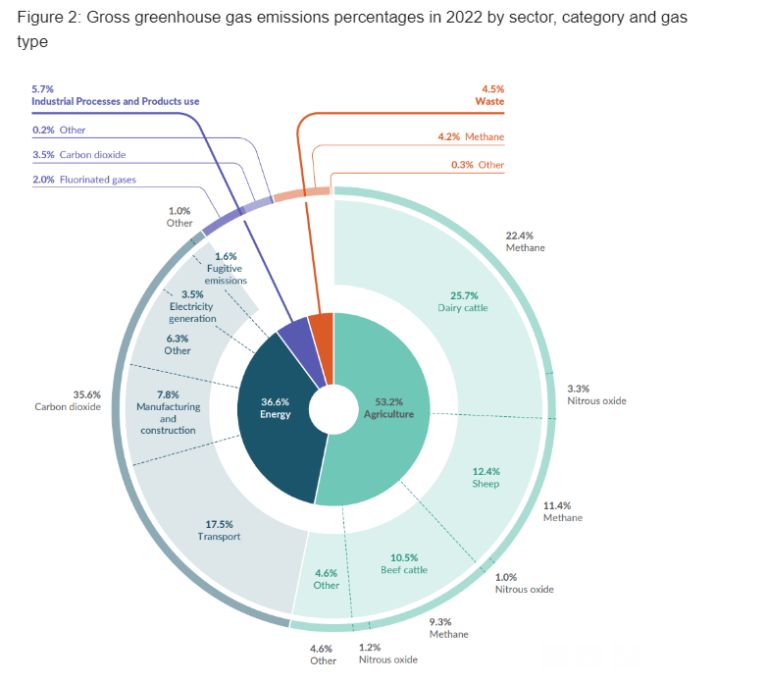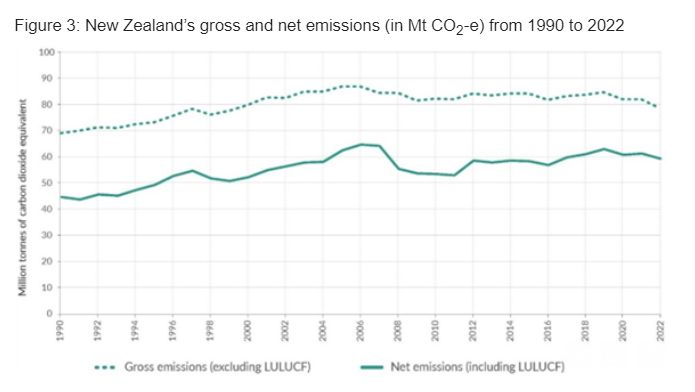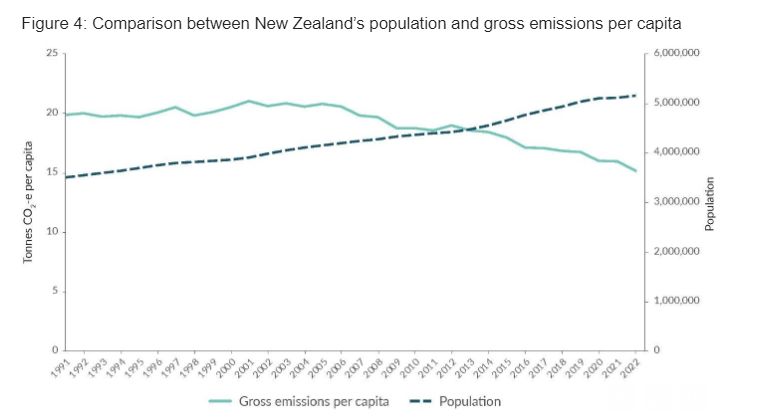New Zealand’s Annual Emissions Fell In 2022, For Third Successive Year
Aotearoa New Zealand’s gross greenhouse gas emissions fell by 4 per cent in 2022.
New Zealand’s Greenhouse Gas Inventory (1990-2022), published today, is the official annual report of all human-induced emissions and removals produced within New Zealand.
It shows that gross emissions were the equivalent of 3.4 million tonnes of carbon dioxide (Mt CO2-e) lower in 2022 than in 2021. 3.4 Mt CO2-e is about three times the emissions produced by all domestic flights in 2022.
This is the third successive decrease year-on-year. New Zealand’s gross emissions for 2022 were 78.4 Mt CO2-e.
The biggest reason behind the decrease was an 8 per cent drop (2.5 Mt CO2-e) in emissions from the energy sector, compared to 2021. This was largely because there was more renewable electricity on the grid, meaning less coal and gas use (1.7 Mt CO2-e).
Wet conditions in 2022 were good for hydroelectricity generation which made up 60 per cent of all electricity generation that year. Wind power on the grid also increased, but as wind only made up 6.5 per cent of electricity generation, this had a smaller overall impact.
Other factors included the closure of Marsden Point oil refinery in March 2022, leading to a 76 per cent (0.6 Mt CO2-e) decrease in emissions from petroleum refining. Emissions from road transport decreased by 1.6 per cent (0.2 Mt CO2-e) due to decreased petrol consumption, even though the estimated kilometres travelled by petrol vehicles remained largely stable.
Agriculture remained the largest emissions-contributing sector in 2022, at 53 per cent of gross emissions, followed by energy at 37 per cent. However, agricultural emissions decreased by 1.4 per cent (0.6 Mt CO2-e) compared to 2021, largely due to a fall in the numbers of sheep and beef cattle, and less synthetic nitrogen fertiliser use.
Forestry and other land uses absorbed 24.5 per cent (19.2 Mt CO2-e) of New Zealand’s total emissions in 2022, slightly less than in 2021. However as gross emissions were lower than in 2021, net emissions were also lower, at 59.2 Mt CO2-e.
Net emissions are calculated by adding up all the emissions we produce, then taking off what is removed by forests and other land uses. Net emission trends in New Zealand are heavily influenced by forest planting and harvesting cycles.
This year’s Inventory is the first submitted under the Paris Agreement. New Zealand has set a Paris Agreement target to reduce net emissions to 50 per cent below gross 2005 levels by 2030. Progress towards this target will be covered in New Zealand’s first Biennial Transparency Report, which will be published by 31 December 2024.
For more information, see New Zealand’s Greenhouse Gas Inventory (1990-2022) or the snapshot of the report.
New Zealand’s emissions in four graphs




Note: Population figures sourced from Stats NZ: Group: Population Estimates – DPE, Table: Estimated Resident Population by Age and Sex (1991+) (Annual-Dec). Data were accurate at 19 March 2024. Table reference: DPE058AA.
Notes:
New Zealand’s Greenhouse Gas Inventory is compiled and submitted as part of our responsibilities under the Paris Agreement and the United Nations Framework Convention on Climate Change.
Please note, accounting rules are applied to Inventory estimates when tracking progress to ensure New Zealand’s contribution is credible and reflects our national circumstances. This means the net emissions estimates reported in the Inventory cannot be used directly for tracking progress. Information on how New Zealand is tracking towards its Paris Agreement target will be included in the Biennial Transparency Report published later this year.
Estimates of projected emissions to 2050 will also be updated later in 2024.
The decrease in gross emissions between 2021 and 2022 was 3.4 Mt CO2-e. Total emissions from domestic aviation in 2022 were 1.0 Mt CO2-e.


 Gordon Campbell: On Winston Peters’ Battle Against The Phantom Legions Of The Woke
Gordon Campbell: On Winston Peters’ Battle Against The Phantom Legions Of The Woke Environmental Defence Society: Infrastructure Summit Should Prioritise Environmental Outcomes
Environmental Defence Society: Infrastructure Summit Should Prioritise Environmental Outcomes Green Party: Just Six Government MPs Needed To Pass Unlawful Occupation Of Palestine Sanctions Bill
Green Party: Just Six Government MPs Needed To Pass Unlawful Occupation Of Palestine Sanctions Bill Ngāti Manuhiri Settlement Trust: Iwi Welcomes Progress On Northland Expressway
Ngāti Manuhiri Settlement Trust: Iwi Welcomes Progress On Northland Expressway Kick Back: Urgent Review Of MSD Needed To Prevent More Rangatahi Sleeping Rough
Kick Back: Urgent Review Of MSD Needed To Prevent More Rangatahi Sleeping Rough Te Pūtahitanga o Te Waipounamu: Government Hellbent On Ignoring Evidence On Impact Of Social Investment For Most Vulnerable Whānau
Te Pūtahitanga o Te Waipounamu: Government Hellbent On Ignoring Evidence On Impact Of Social Investment For Most Vulnerable Whānau Rangahau Aotearoa Research NZ: One In Two New Zealanders Are Affected By The Cost Of Living Crisis
Rangahau Aotearoa Research NZ: One In Two New Zealanders Are Affected By The Cost Of Living Crisis


